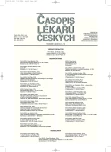Cancer microenvironment affects biological properties of tumor cells – tumor as an embryologic problem?
Authors:
Karel Smetana ml. 1,2; Barbora Dvořánková 1,2; Lukáš Lacina 1,2,3; Eliška Krejčí 1; Miloš Grim 1,2
Authors‘ workplace:
Univerzita Karlova v Praze, 1. lékařská fakulta, Anatomický ústav
1; Univerzita Karlova v Praze, 2. lékařská fakulta, Centrum buněčné terapie a tkáňových náhrad
2; Univerzita Karlova v Praze, 1. lékařská fakulta, Klinika dermatovenerologie
3
Published in:
Čas. Lék. čes. 2010; 149: 572-575
Category:
Review Article
Overview
Mutual epithelial-mesenchymal interaction represents a fundamental control mechanism during the development of organs and tissues. This review article demonstrates the importance of such interaction for tumor formation where it influences the biological properties of cancer stem cell and tumor itself. The teratoma and melanoma are employed as examples to demonstrate the influence of embryonic microenvironment on the biological properties of tumor, mainly on its potential to metastasize. The manipulation of cancer microenvironment represents the perspective therapeutic tool for cancer treatment in future.
Key words:
cancer microenvironment, cancer-associated fibroblast, squamous cell carcinoma, neural crest, melanoma.
Sources
1. Weinber RA. The Biology of Cancer. New York: Garland Science, 2007.
2. Sell S. Stem cell origin of cancer and differentiation therapy. Crit Rev Oncol Hematol 2004; 51 : 1–28.
3. Motlík J, et al. Porcine epidermal stem cells as a biomedical model for wound healing and normal/malignant epithelial cell propagation. Theriogenology 2007; 67 : 105–111.
4. Walker MR, et al. The stem cell niche. J Path 2009; 217 : 169–180.
5. Plzák J, et al. Epithelial – stromal interaction in squamous cell epithelium – derived tumors: an important new player in the control of tumor biological properties. Anticancer Res 2010; 30 : 455–462.
6. De Wever O, et al. Stromal myofibroblasts are drivers of invasive cancer growth. Int J Cancer 2008; 123 : 2229–2238.
7. Hwang RF, et al. Cancer-associated stromal fibroblasts promote pancreatic tumor progression. Cancer Res 2008, 68 : 918–926.
8. Strnad H, et al. Head and neck quamous cancer fibroblasts produce growth factors influencing phenotype of normal human keratinocytes. Histochem Cell Biol 2009; 133 : 201–211.
9. Lacina L, et al. Marker profiling of normal keratinocytes identifies the stroma from squamous cell carcinoma of the oral cavity as a modulatory microenvironment in co-culture. Int J Radiation Biol 2007; 83 : 837–848.
10. Lacina L, et al. Stromal fibroblasts from basal cell carcinoma affect phenotype of normal keratinocytes Brit J Dermatol 2007; 156 : 819–829.
11. Kideryová L, et al. Phenotypic characterization of human keratinocytes in coculture reveals differential effects of fibroblasts from benign fibrous histiocytoma (dermatofibroma) as compared to cells from its malignant form and to normal fibroblasts. J Dermatol Sci 2009; 55 : 18–26.
12. Briegel KJ. Embryonic transcription factors in human breast cancer. IUBMB Life 2006; 58 : 123–132.
13. Ohyama M, et al. The mesenchymal component of hair follicle neogenesis: background, methods and molecular characterization. Exp Dermatol 010; 19 : 89–99.
14. Mishra PJ, et al. Carcinoma – associated fibroblast – like differentiation of human mesenchymal stem cells. Cancer Res 2008; 68 : 4331–4339.
15. Petersen OW, et al. Epithelial to mesenchymal transition in human breast cancer can provide a nonmalignant stroma. Am J Pathol 2003; 162 : 391–402.
16. Smetana K Jr, et al. Human hair follicle and interfollicular keratinocyte reactivity to mouse HPV16-transformed cells: an in vitro study. Oncol Rep 2008; 20 : 75–80.
17. Solinas G, et al. Tumor-associated macrophages (TAM) as major players of the cancer-related inflammation. J Leukoc Biol 2009; 86 : 1065–1073.
18. Hendrix MJ, et al. Reprogramming metastatic tumour cells with embryonic microenvironments. Nat Rev Cancer 2007; 7 : 246–255.
19. Lee AS, et al. Effects of cell number on teratoma formation by human embryonic stem cells. Cell Cycle 2009; 8 : 2608–2612.
20. Illmensee K, Mintz B. Totipotency and normal differentiation of single teratocarcinoma cells cloned by injection into blastocysts. Proc Natl Acad Sci USA 1976; 73 : 549–553.
21. Mintz B, Illmensee K. Normal genetically mosaic mice produced from malignant teratocarcinoma cells. Proc Natl Acad Sci USA 1975; 72 : 3585–3589.
22. Dolberg DS, Bissell MJ. Inability of Rous sarcoma virus to cause sarcomas in the avian embryo. Nature 1984; 309 : 552–556.
23. Hall BK. The neural crest and neural crest cells: discovery and significance for theories of embryonic organization. J Biosci 2008; 33 : 781–793.
24. Sieber-Blum M, et al. Pluripotent neural crest stem cells in the adult hair follicle. Dev Dyn 2004; 231 : 258–269.
25. Krejčí E, Grim M. Isolation and characterization of neural crest stem cells from adult human hair follicles. Folia Biol 2010; 56 : 149–157.
26. Karafiát V, et al. Transcription factor c-Myb is involved in the regulation of the epithelial-mesenchymal transition in the avian neural crest. Cell Mol Life Sci 2005; 62 : 2516–2525.
27. Díez-Torre A, et al. Reprogramming of melanoma cells by embryonic microenvironments. Int J Dev Biol 2009; 53 : 1563–1568.
28. Bittner M, et al. Molecular classification of cutaneous malignant melanoma by gene expression profiling. Nature 2000; 406 : 536–540.
29. Seftor EA, et al. Expression of multiple molecular phenotypes by aggressive melanoma tumor cells: role in vasculogenic mimicry. Crit Rev Oncol Hematol 2002; 44 : 17–27.
30. Joyce JA. Therapeutic targeting of the tumor microenvironment. Cancer Cell 2005; 7 : 513–520.
31. Smetana K Jr, et al. Kombinace monoklonálních protilátek nebo jejich Fab fragmentů pro použití jako léčivo a farmaceutický přípravek tyto protilátky nebo jejich Fab fragmenty obsahující. Český patent č. 301597, 2010.
Labels
Addictology Allergology and clinical immunology Angiology Audiology Clinical biochemistry Dermatology & STDs Paediatric gastroenterology Paediatric surgery Paediatric cardiology Paediatric neurology Paediatric ENT Paediatric psychiatry Paediatric rheumatology Diabetology Pharmacy Vascular surgery Pain management Dental HygienistArticle was published in
Journal of Czech Physicians

Most read in this issue
- Kidney diseases in pregnancy
- Past, present and future of neuroprotection
- Demographic view on primary health care physicians in the Czech Republic – present state as the headstone for the future development
- Alcohol in children and adolescents – prevention and treatment
